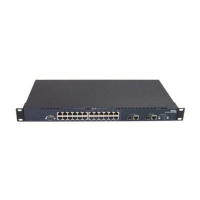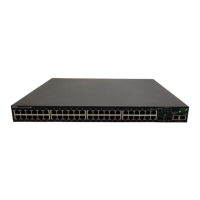1278 BigIron RX Series Configuration Guide
53-1002253-01
Configuring a static IPv6 route
50
A metric is a value that the router uses when comparing this route to other static routes in the IPv6
static route table that have the same destination. The metric applies only to routes that the router
has already placed in the IPv6 static route table.
The administrative distance is a value that the router uses to compare this route with routes from
other route sources that have the same destination. (The router performs this comparison before
placing a route in the IPv6 route table.) This parameter does not apply to routes that are already in
the IPv6 route table. In general, a low administrative distance indicates a preferred route. By
default, static routes take precedence over routes learned by routing protocols. If you want a
dynamic route to be chosen over a static route, you can configure the static route with a higher
administrative distance than the dynamic route.
TABLE 226 Static IPv6 route parameters
Parameter Configuration details Status
The IPv6 prefix and prefix length of
the route’s destination network.
You must specify the <dest-ipv6-prefix>
parameter in hexadecimal using 16-bit
values between colons as documented in
RFC 2373.
You must specify the <prefix-length>
parameter as a decimal value. A slash
mark (/) must follow the <ipv6-prefix>
parameter and precede the
<prefix-length> parameter.
Mandatory for all static IPv6
routes.
The route’s next-hop gateway, which
can be one of the following:
• The IPv6 address of a next-hop
gateway.
• A tunnel interface.
You can specify the next-hop gateway as
one of the following types of IPv6
addresses:
• A global address.
• A link-local address.
If you specify a global address, you do not
need to specify any additional parameters
for the next-hop gateway.
If you specify a link-local address, you
must also specify the interface through
which to access the address. You can
specify one of the following interfaces:
• An Ethernet interface.
• A tunnel interface.
• A virtual interface (VE).
If you specify an Ethernet interface, also
specify the port number associated with
the interface. If you specify a VE or tunnel
interface, also specify the VE or tunnel
number.
You can also specify the next-hop gateway
as a tunnel interface. If you specify a
tunnel interface, also specify the tunnel
number.
Mandatory for all static IPv6
routes.
The route’s metric. You can specify a value from 1 – 16. Optional for all static IPv6
routes. (The default metric
is 1.)
The route’s administrative distance. You must specify the distance keyword
and any numerical value.
Optional for all static IPv6
routes. (The default
administrative distance is
1.)

